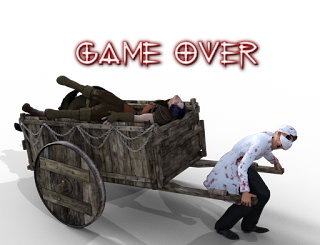System graphics, in the
System folder, are used for the Main and Battle menus. These are some I created (modified) a while ago. They are free to use for any RM2K3 game.
System Sets
Here are two basic system sets I created using the templates below.
Gold Frame
This system set sports a gold frame on a black background that gives it a royalty feel.

This system set has a parchment background to give games an archaic look and feel.
System Templates
Here are some basic templates to enable you to make your own custom system sets.

This is the basic System layout that determines how the messages appears, including text colors. System sets (imported in the
System folder) are for the main interface. The image size is 160x80.

Breaking the template down into its component parts, we can have a better understanding about how the components work.
A: Size: 32x32. This is the background color of the window.
B: Size: 32x32. This is the frame around the window and up and down arrows for scrolling through options. The arrows are 8x8 in size.
C: Size: 32x32. These two are the patterns used for the command cursor. If they are two different patterns, the cursor will flash rather than be static if they are both the same.
D: These are the four animated arrows used in shops. Each is 8x8 in size, comprising four frames each. The first row is for stat increases, the second is for unequippable items, the third is for stat decreases, and the fourth is when an item is already equipped.
E: Size: 16x16. This is the background color of the menu, used as "opacity".
F: Size: 16x16. This is the letter shadow color, displayed "behind" the letters to give it a shadow effect.
G: These are the numbers used for timers. There are twelve in total, each one 8x16 in size and comprising a set of two numbers, with the last one a colon (or other separator).
H: Size: 16x16. These are the two shadows for airships, which are displayed on the map whenever an airship is used as a vehicle.
The last two rows are for the twenty basic colors used in the game. Each is 16x16 in size. The first four are the "system" colors, where:
0: The default text color.
1: The stats default color.
2: The color for when stats increase.
3: The color for when stats decrease or when commands are unavailable.
4: The color for when HP or SP decrease.
 This was the first I ever created (or re-created would be more accurate). The numbers on the gauge aren't really that clear, but I kept it as is for posterity.
This was the first I ever created (or re-created would be more accurate). The numbers on the gauge aren't really that clear, but I kept it as is for posterity. This template shows the component elements of the above template.
This template shows the component elements of the above template.












